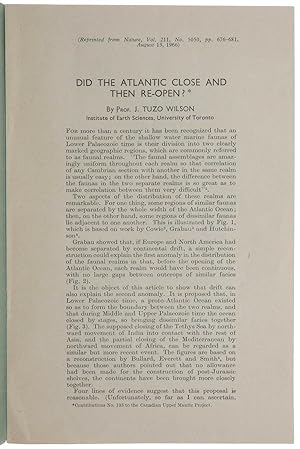Atlantic Close Re Open Offprint Nature by Tuzo Wilson John (1 results)
FeedbackSearch filters
Product Type
- All Product Types
- Books (1)
- Magazines & Periodicals (No further results match this refinement)
- Comics (No further results match this refinement)
- Sheet Music (No further results match this refinement)
- Art, Prints & Posters (No further results match this refinement)
- Photographs (No further results match this refinement)
- Maps (No further results match this refinement)
- Manuscripts & Paper Collectibles (No further results match this refinement)
Condition
- All Conditions
- New (No further results match this refinement)
- Used (1)
Binding
- All Bindings
- Hardcover (1)
- Softcover (No further results match this refinement)
Collectible Attributes
- First Edition (1)
- Signed (No further results match this refinement)
- Dust Jacket (No further results match this refinement)
- Seller-Supplied Images (1)
- Not Print on Demand (1)
Language (1)
Price
- Any Price
- Under £ 20 (No further results match this refinement)
- £ 20 to £ 35 (No further results match this refinement)
- Over £ 35
Free Shipping
Seller Location
Seller Rating
-
Did The Atlantic Close And Then Re-Open? Offprint from: Nature, Vol. 211, No. 5050, August 13, 1966
Published by Macmillan, London, 1966
First Edition
£ 2,188.98
Convert currencyFree shipping from Denmark to United KingdomQuantity: 1 available
Add to basketHardcover. First edition. THE TECTONIC CYCLE. First edition, very rare offprint, of this landmark paper elucidating the history and mechanism of continental drift by "one of the most imaginative Earth scientists of his generation" (DSB). "In 1966, J. Tuzo Wilson published 'Did the Atlantic Close and then Re-Open?' in the journal Nature. The Canadian author introduced to the mainstream the idea that continents and oceans are in continuous motion over our planet's surface. Known as plate tectonics, the theory describes the large-scale motion of the outer layer of the Earth. It explains tectonic activity (things like earthquakes and the building of mountain ranges) at the edges of continental landmasses (for instance, the San Andreas Fault in California and the Andes in South America)" (Heron). Alfred Wegener (1880-1930) had already suggested in the early 1900s that continents move around the surface of the earth, specifically that there had been a super-continent (Pangaea) where now there is a great ocean (the Atlantic). In the present paper, Wilson explained the geological evidence that North America and Europe were once separated across an ocean before the Atlantic Ocean. This ocean closed in stages as the continents that used to be separated by the ocean converged by subduction and eventually collided in a mountain-building event. The combined continent was then sliced apart and the continents drawn away from each other once more as the modern Atlantic Ocean opened. The paper combined the nascent ideas of divergent and convergent plate boundaries into a conceptual model that matched observations of geological features around the world. The tectonic cycle he described now goes by 'the Wilson Cycle' or the 'Supercontinent Cycle' and still governs how we think of the evolution of tectonic plates through time. "Wilson's great idea was a crucial step forward. It reopened the whole question of 'what happened before Pangea?' By suggesting that his 'proto-Atlantic' had opened within an earlier supercontinent (just as the Atlantic did within Pangea) he also linked his process to a grander cycle leading from one supercontinent Earth to another" (Nield). As was often the case for offprints from Nature (e.g., the famous Watson/Crick DNA offprint), this offprint is printed in a smaller format than the journal issue, with the text reset. No copies in auction records or on OCLC. In the early twentieth century the prevailing wisdom regarding how mountain belts were formed and why the sea is deep was that the Earth started out as a molten ball and gradually cooled. When it cooled, heavier metals such as iron sank down and formed the core, while lighter metals such as aluminium stayed up in the crust. The cooling also caused contraction and the pressure produced by contraction caused some parts of the crust to buckle upwards, forming mountains, while other parts of the crust buckled downwards, creating ocean basins. "Originally a devotee of the contracting-Earth hypothesis, [Tuzo Wilson] became a convert to [continental] drift as he was entering his fifties (by which time he had been Professor of Geophysics at Toronto for a decade). Swiftly recanting his former views, Tuzo saw the way the Earth's mountain belts were often superimposed upon one another, and set about explaining it in terms of plate tectonics. In a classic paper published in Nature in 1966 and titled 'Did the Atlantic close and then reopen?' he addressed the coincidence of the modern Atlantic with two mountain ranges called the Caledonides in Europe and the Appalachians in the USA. It was the very first time the new plate tectonics had been extended back to the pre-Pangean Earth. "These two mountain ranges are really one and the same except that they are now separated by the Atlantic Ocean, which cut the range in two at a low angle when it opened between them. At one time the two belts had been joined, end-to-end, Caledonides in the north, Appalachians in the south; and the collision that had created t.


